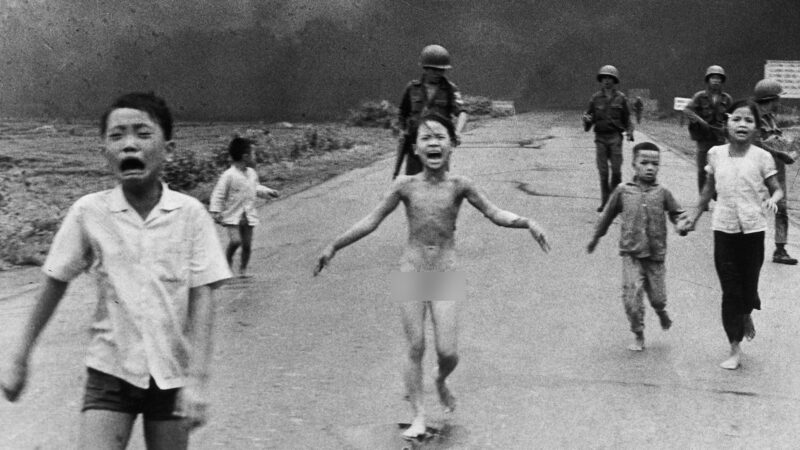On Wednesday the United States marked a grim milestone.
It’s been fifty years since the country was driven out of Ho Chi Minh City (then Saigon), ending the country’s 20 years of aggression against Vietnam.
Here in the States, the conflict is generally called the “Vietnam War”—but it’s time we start calling it what it really was: a genocide.
WHAT WENT DOWN: Beginning in 1955, the United States propped up the authoritarian, brutal, and illegal dictatorship of Ngo Dinh Diem in the southern half of the country.
The stated reason for the support—which included hundreds of millions of dollars and CIA assistance for Diem’s secret police—was the fear that if Communists came to power in Vietnam, it would spread through Southeast Asia and eventually threaten the American way of life.
The United States government even helped Diem block democratic elections that would have unified the country in 1956.
That’s because U.S. officials—including President Eisenhower—feared Ho Chi Minh—a communist—would win.
The blocked elections helped drive the country into a full-scale Civil War by the early ’60s.
CHANGING HISTORY: Historians now believe that Ho Chi Minh and the Communists would have won that civil war, had the U.S. stayed out of the country’s affairs.
Instead of allowing democratic self-determination, as supposedly guaranteed by the U.N. charter, the “greatest country in the world” unleashed hell.
By the end of the war, the U.S. had sent over half a million troops to the far-off country and spent over $1.7 trillion (in today’s dollars) to try and suppress the will of the people.
BUT HERE’S THE THING: Historians now also agree that at no point did communists in Vietnam—a country about the size of New Mexico 7,000 miles from the U.S. mainland—ever directly threaten the American way of life.
Even after they “won,” at no point did Vietnamese communists have plans to attack the U.S. It never had the military or technology to do so anyway.
What Vietnamese communists did threaten, however, was American capitalists’ political and economic dominance.
Rich, white, male leaders in Washington felt that if poor people of color could defeat the largest and most technologically advanced military in the history of the world, then America—and capitalism’s—reputation would forever be tarnished.
And that could not be allowed to happen.
BUT WAS IT A GENOCIDE? According to the U.N. Genocide Convention of 1948, genocide is violence committed with intent to destroy, in whole or in part, a national, ethnical, racial, or religious group. That violence can include:
- Killing members of the group
- Causing serious physical or mental harm to members of the group
- Deliberately inflicting on the group conditions of life calculated to bring about its physical destruction in whole or in part
- Imposing measures intended to prevent births within the group
- Forcibly transferring children of the group to another group
From the mid 50’s until April 30, 1975, the United States of America set out destroy a specific group: Vietnamese communists.
To do this, they did three of the five acts of violence above—dropping more bombs on the country than were used in the entirety of World War II.
AMERICA’S WRATH: American troops hunted down and indiscriminately killed Vietnamese communists—with both conventional and chemical weapons—along with anyone who they thought might sympathize with them.
In fact, U.S. military doctrine often treated whole areas as “free-fire zones”, meaning anyone present was considered an enemy and could be shot—regardless of age or combat status. In addition to genocide, this is a war crime.
The My Lai Massacre is the most famous example of this.
In 1968, over 300 unarmed civilians, including women and children, were systematically slaughtered by American troops.
THE KILLING CONTINUED: Although not often mentioned in the history of America’s aggression towards Vietnamese communists, it continued to punish Vietnam for years afterward, economically and diplomatically.
After the fall of Saigon, the U.S. implemented a total trade embargo that lasted for twenty more years.
That embargo, along with the lingering effects of chemical weapons and unexploded bombs helped kill hundreds of thousands more—even after the “war” ended.
And all of this was to destroy a single group: Vietnamese communists. A genocide.
WHY DON’T WE CALL IT A GENOCIDE? For two very important reasons. First, under the U.N. genocide convention, legally a genocide is only a genocide if it targets a national, ethnical, racial, or religious—not political—group.
That’s because when the charter was being drafted in the late 40’s, Stalin had perpetrated his own genocide against political enemies—and fought to keep the designation out of international law.
And second: American propaganda.
The U.S. educational system works overtime to brainwash children into believing their country is the “greatest country in the world,” from kindergarten through high school.
Presenting children with credible evidence that this is indeed not the case—including that the greatest country in the world would knowingly slaughter millions of people who disagreed with them politically—would effectively burst that bubble.
WHY IT MATTERS: Correctly calling the American genocide of Vietnam matters for two important reasons.
First, as the British philosopher George Santayana once said, those who fail to learn the lessons of history are doomed to repeat them.
And two—in order for us all to heal—we need to admit the great atrocity that was committed by our country.
There is absolutely no logical reason that justifies the blood spilled in the name of “stopping communism.”
FINAL POINT: If we can’t name what happened in Vietnam for what it was—a genocide—then what does that say about us?
If we still can’t face the reality that millions were slaughtered not for freedom, but for profit and ideology, then we haven’t learned a damn thing. And we will do it again.
Andrew Springer is the co-founder and CEO of NOTICE News. His work has appeared on NBC News, ABC News, and Mashable, and he’s a former communications director for the Bernie Sanders campaign.

